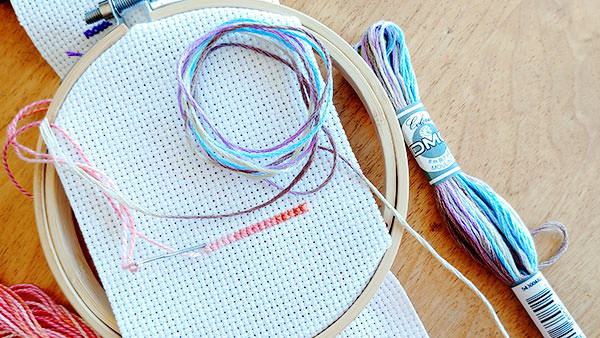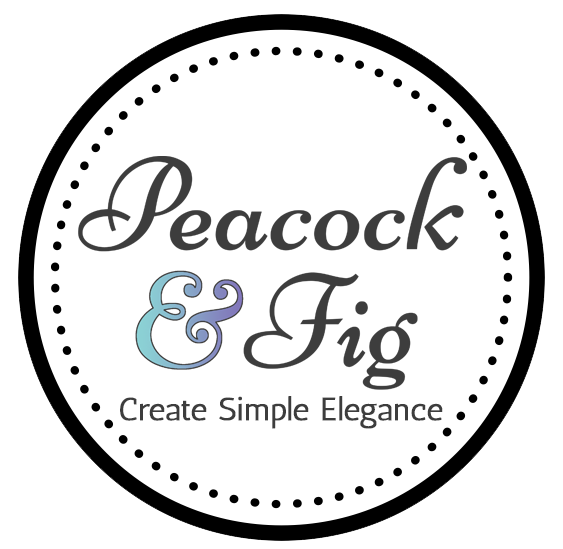If you’ve ever been wooed by the various color variations threads like DMC’s new Coloris line on your shopping sprees, you’re not alone. These gorgeous variegated threads can be subtle or striking, and add a lot of beautiful tonality and gradations to your stitching. But they are different to use because of the color variations, so in this tutorial I’ll show you how to best use these threads to really show off their uniqueness.

Color variations threads: Tips for using variegated floss
- Use the English method to stitch with variegated threads to get “solid” colour transitions
- Using a pin stitch to anchor your floss will give smoother colour transitions than using the loop method
- For bigger areas of stitching, you can either:
- work back and forth (vertically or horizontally)
- cut strands of floss starting at the same point in one colour for each row or column of stitching
- Variegated floss works really well for patterns that have single lines of stitching, such as for text or patterns such as the Flowers of Love pattern pictured below. You can download this free pattern by signing up for the free Peacock Lounge, members get access to all the free patterns on the site.

Summary

Article Name
Do you love color variations threads like DMC's new Coloris line? Learn how to use variegated threads to really show off their uniqueness!
Description
Do you love color variations threads like DMC's new Coloris line? Learn how to use variegated threads to really show off their uniqueness!
Author
Dana Batho
Publisher Name
Peacock & Fig
Publisher Logo

4 Responses
Kate Stiffler
Dana, I enjoy your videos because even though I have been stitching my entire life, there are always new ideas and trends.
I have a question. Knowing there is no wrong way to stitch, I notice your stitches are completed top to bottom, whether you are stitching English or Danish method. I have always stitched bottom to top. Does it make a difference?
Thank you!
Dana Batho
Hi Kate, that’s a good question! Nope, it doesn’t make one iota of difference, it’s whatever you’re comfortable with. It doesn’t even matter which direction you go (like / first then \, or vice versa). As long as you’re consistent with the direction of your stitches, which end you start the stitch from doesn’t really matter. Sometimes I do mix it up on projects, it depends what other stitches are around and what direction I’m travelling in. I meander over my pieces. 🙂
Susan
Hi Dana, just watched your newest video and, as always, enjoyed it immensely. There’s always something to learn, even for the most experienced stitcher.
When you’ve worked with color variations thread and come to the end of the row or section, have you ever tried turning your work upside down and continue working? I see it would continue with the color you were just working with, but I’m not certain how the thread variations would look when you come to the end of the second row or section, turn your work right side up and continue. I suspect it would vary depending on the amount of variation each thread has (especially working with the coloris floss). I haven’t tried it, but hoping you’ve had some experience with that method and have some words of wisdom about it.
Dana Batho
Hi Susan, thanks for your comment! No, I’ve never tried turning my stitching upside down — that would confuse the tar out of me trying to follow my pattern. I’ve heard of stitchers flipping their stitching each time to get their needle to go in the right hole — again, that would just confuse me as then you’re looking at your project backwards. It doesn’t matter which direction you travel, although those who want their backs to look pristine will say you always have to travel in a consistent manner. I’ve done small sections using the variegated floss on projects, I either work top to the bottom in rows, or from one side to the other in columns. No matter what you do, if you’re not starting a new strand with the exact same tones as the row above (or beside if working vertically), you’re going to end up with the colours getting a little mixed up in spots. Like in that sample, if I did a 10×10 block working back and forth (say left to right for the first row, right to left for the second, etc), you’d end up with light pink up against bright orange in sections. I don’t mind that at all, that’s part of the beauty of the floss — the finished product is always a little unpredictable. 🙂